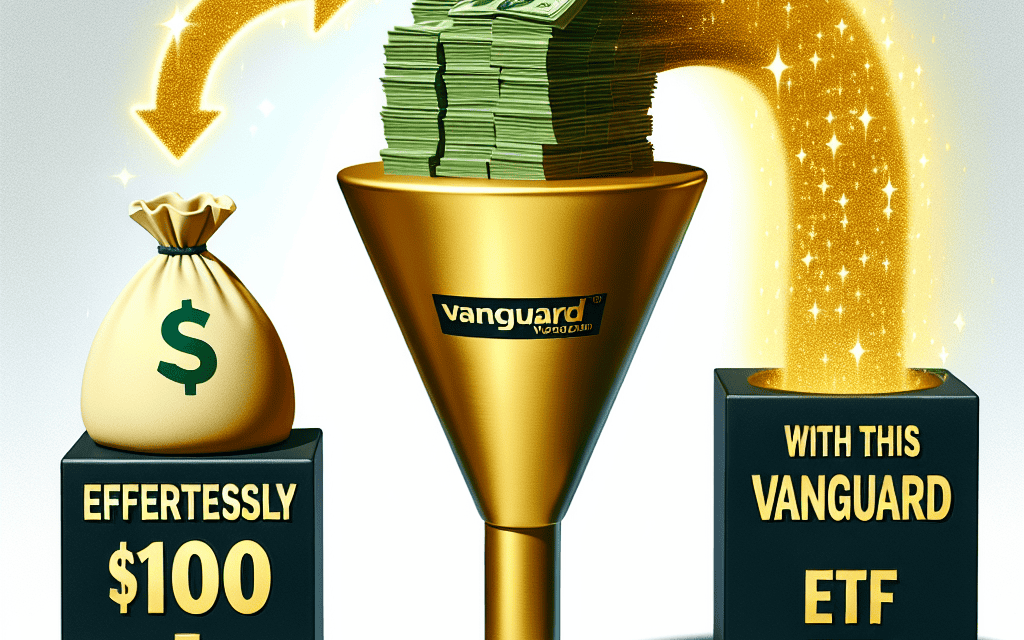“Unlock Wealth: Turn $1,000 into $143,000 Effortlessly with This Vanguard ETF!”
Introduction
Investing in the stock market can often seem daunting, but with the right strategies and tools, it can be a powerful way to grow your wealth. One such tool is the Vanguard ETF, a financial instrument that has gained popularity for its potential to deliver substantial returns with minimal effort. Imagine turning a modest investment of $1,000 into a remarkable $143,000. This isn’t just a dream; it’s a possibility with the right approach and understanding of market dynamics. By leveraging the benefits of diversification, low fees, and the expertise of Vanguard’s management, investors can tap into the growth potential of this ETF, making it an attractive option for both novice and seasoned investors looking to enhance their financial portfolios.
Understanding the Power of Compound Interest in Vanguard ETFs
Investing in the stock market can often seem daunting, especially for those who are new to the world of finance. However, understanding the power of compound interest can transform this perception, turning what seems like a complex endeavor into a straightforward path to wealth accumulation. One of the most effective ways to harness the benefits of compound interest is through Exchange-Traded Funds (ETFs), particularly those offered by Vanguard, a company renowned for its low-cost investment options. By investing in a Vanguard ETF, it is possible to transform an initial investment of $1,000 into a substantial sum of $143,000 over time, with minimal effort required.
The concept of compound interest is fundamental to understanding how such growth is achievable. Unlike simple interest, which is calculated only on the principal amount, compound interest is calculated on the principal amount and also on the accumulated interest from previous periods. This means that your investment grows at an increasing rate over time, as the interest itself begins to earn interest. The longer the investment period, the more pronounced the effects of compounding become, making time a crucial factor in the growth of your investment.
Vanguard ETFs are particularly well-suited for investors looking to capitalize on compound interest due to their diversified nature and low expense ratios. These funds pool money from many investors to purchase a diversified portfolio of stocks, bonds, or other securities, which helps to spread risk. Moreover, Vanguard is known for its commitment to keeping costs low, which is essential because high fees can significantly erode the benefits of compounding over time. By minimizing expenses, more of your money remains invested and working for you.
To illustrate the potential of compound interest with a Vanguard ETF, consider an investment in the Vanguard Total Stock Market ETF (VTI), which aims to track the performance of the CRSP US Total Market Index. Historically, the stock market has returned an average of about 7% annually after inflation. Assuming this rate of return, an initial investment of $1,000 in VTI could grow to approximately $143,000 over a period of 50 years, thanks to the power of compounding. This example underscores the importance of starting early and allowing your investment to grow over a long period.
Furthermore, the ease of investing in ETFs makes them an attractive option for both novice and experienced investors. With the advent of online brokerage platforms, purchasing shares of a Vanguard ETF is as simple as a few clicks. This accessibility, combined with the potential for significant growth through compound interest, makes ETFs an appealing choice for those looking to build wealth over time.
In conclusion, the transformative power of compound interest cannot be overstated, especially when leveraged through a well-chosen Vanguard ETF. By understanding and utilizing this financial principle, investors can turn a modest initial investment into a substantial nest egg. The key lies in starting early, remaining patient, and allowing time to work its magic. As demonstrated, an investment of $1,000 can indeed grow into $143,000, illustrating that with the right approach, building wealth can be both effortless and rewarding.
The Magic of Long-Term Investing: How $1,000 Can Grow Exponentially
Investing in the stock market has long been heralded as a pathway to financial growth, yet many individuals remain hesitant due to perceived complexities and risks. However, the magic of long-term investing lies in its simplicity and potential for exponential growth, particularly when utilizing exchange-traded funds (ETFs) like those offered by Vanguard. By understanding the principles of compounding and the benefits of a diversified portfolio, even a modest initial investment can yield substantial returns over time.
Consider the scenario of investing $1,000 in a Vanguard ETF, a strategy that has proven effective for countless investors. Vanguard, known for its low-cost, diversified funds, offers a range of ETFs that track various indices, providing exposure to a broad spectrum of the market. One such ETF, the Vanguard Total Stock Market ETF (VTI), encompasses the entire U.S. stock market, including small-, mid-, and large-cap growth and value stocks. This diversification minimizes risk while maximizing potential returns, making it an ideal choice for long-term investors.
The power of compounding is a fundamental concept that underpins the success of long-term investing. When you invest in an ETF like VTI, any dividends earned are reinvested, allowing your investment to grow exponentially over time. This process of earning returns on both your initial investment and the accumulated returns from previous periods is what transforms a modest sum into a substantial nest egg. For instance, historical data suggests that the U.S. stock market has averaged an annual return of approximately 7% after inflation. At this rate, an initial investment of $1,000 could grow to over $143,000 in 50 years, assuming dividends are reinvested and the market continues to perform at its historical average.
Moreover, the discipline of long-term investing helps mitigate the impact of market volatility. While short-term market fluctuations can be unsettling, a long-term perspective allows investors to ride out these ups and downs, focusing instead on the overall upward trajectory of the market. This approach not only reduces stress but also increases the likelihood of achieving significant financial growth. By maintaining a steady course and resisting the urge to react to short-term market movements, investors can harness the full potential of their investments.
In addition to the financial benefits, long-term investing in ETFs like those offered by Vanguard is also time-efficient. Unlike active trading, which requires constant monitoring and decision-making, investing in a diversified ETF allows individuals to adopt a “set it and forget it” strategy. This hands-off approach is particularly appealing to those who may not have the time or expertise to engage in active trading but still wish to benefit from the growth potential of the stock market.
In conclusion, transforming $1,000 into $143,000 through long-term investing is not only possible but also accessible to anyone willing to embrace the principles of compounding and diversification. By choosing a reputable ETF such as the Vanguard Total Stock Market ETF and maintaining a long-term perspective, investors can achieve substantial financial growth with minimal effort. The key lies in starting early, remaining disciplined, and allowing time to work its magic, ultimately turning a modest investment into a significant financial asset.
A Beginner’s Guide to Investing in Vanguard ETFs for Maximum Returns
Investing in the stock market can often seem daunting, especially for beginners who are just starting to explore the myriad of options available. However, with the right guidance and tools, even novice investors can achieve significant returns. One such tool is the Vanguard ETF, a popular choice among investors for its potential to transform modest investments into substantial wealth over time. By understanding how to effectively utilize these ETFs, you can turn an initial investment of $1,000 into a remarkable $143,000, all while minimizing effort and maximizing returns.
Vanguard ETFs, or Exchange-Traded Funds, are investment funds that are traded on stock exchanges, much like individual stocks. They offer a diversified portfolio of assets, which can include stocks, bonds, or other securities. This diversification is a key advantage, as it helps to spread risk across various investments, thereby reducing the impact of any single asset’s poor performance on the overall portfolio. For beginners, this means that investing in a Vanguard ETF can provide a balanced approach to entering the stock market, without the need to meticulously research and select individual stocks.
One of the most compelling aspects of Vanguard ETFs is their low-cost structure. Vanguard is renowned for its commitment to keeping costs low, which is crucial for maximizing returns over the long term. Lower fees mean that more of your money is working for you, rather than being siphoned off in management costs. This cost efficiency, combined with the power of compounding, can significantly enhance the growth of your investment over time. Compounding refers to the process where the returns on your investment generate their own returns, creating a snowball effect that can lead to exponential growth.
To illustrate the potential of Vanguard ETFs, consider the historical performance of the Vanguard S&P 500 ETF (VOO). This ETF aims to track the performance of the S&P 500 Index, which comprises 500 of the largest companies in the United States. Over the past several decades, the S&P 500 has delivered an average annual return of approximately 10%. By investing $1,000 in VOO and allowing it to grow at this average rate, your investment could potentially reach $143,000 over a period of 40 years. This example underscores the power of long-term investing and the benefits of starting early.
Moreover, Vanguard ETFs offer the flexibility of being easily bought and sold on the stock market, providing liquidity and convenience for investors. This accessibility makes it simple for beginners to enter and exit positions as needed, without the complexities often associated with other investment vehicles. Additionally, Vanguard provides a wealth of educational resources and tools to help investors make informed decisions, further simplifying the investment process for those new to the market.
In conclusion, investing in Vanguard ETFs presents a compelling opportunity for beginners to achieve substantial returns with minimal effort. By leveraging the benefits of diversification, low costs, and compounding, investors can transform a modest initial investment into significant wealth over time. As with any investment, it is important to conduct thorough research and consider your financial goals and risk tolerance. However, with the right approach, Vanguard ETFs can serve as a powerful tool in your investment arsenal, paving the way for financial growth and security.
The Role of Diversification in Achieving Financial Growth with ETFs

Diversification plays a pivotal role in achieving financial growth, particularly when investing in Exchange-Traded Funds (ETFs). By spreading investments across a wide array of assets, investors can mitigate risks while maximizing potential returns. One compelling example of this strategy in action is the Vanguard Total Stock Market ETF (VTI), which has demonstrated the power of diversification in transforming modest investments into substantial wealth over time.
To understand how a $1,000 investment can grow to $143,000, it is essential to delve into the mechanics of diversification and the unique advantages offered by ETFs like VTI. Unlike individual stocks, which can be volatile and unpredictable, ETFs provide exposure to a broad spectrum of the market. VTI, for instance, encompasses the entire U.S. stock market, including small-, mid-, and large-cap stocks. This extensive coverage ensures that investors are not overly reliant on the performance of a single company or sector, thereby reducing the impact of market fluctuations on their portfolios.
Moreover, the historical performance of VTI underscores the benefits of a diversified approach. Over the past few decades, the U.S. stock market has generally trended upward, driven by economic growth, innovation, and corporate profitability. By investing in VTI, individuals can capture this overall market growth, rather than attempting to time the market or pick individual winners. This strategy not only simplifies the investment process but also aligns with the long-term nature of wealth accumulation.
In addition to diversification, the cost-effectiveness of ETFs like VTI further enhances their appeal. With low expense ratios compared to mutual funds, ETFs allow investors to retain more of their returns. This cost efficiency, combined with the compounding effect of reinvested dividends, can significantly boost the growth of an investment over time. For instance, assuming an average annual return of around 10%, a $1,000 investment in VTI could indeed grow to approximately $143,000 over a 40-year period. This impressive growth trajectory highlights the potential of disciplined, long-term investing in a diversified ETF.
Furthermore, the liquidity and flexibility of ETFs contribute to their suitability for a wide range of investors. Unlike some investment vehicles that may have restrictions or lock-in periods, ETFs can be bought and sold on the stock exchange throughout the trading day. This feature provides investors with the ability to adjust their portfolios in response to changing market conditions or personal financial goals, without incurring significant costs or penalties.
In conclusion, the Vanguard Total Stock Market ETF exemplifies how diversification can be a powerful tool in achieving financial growth. By offering broad market exposure, cost efficiency, and flexibility, VTI enables investors to harness the potential of the entire U.S. stock market. While no investment is without risk, the historical performance and inherent advantages of diversified ETFs make them an attractive option for those seeking to grow their wealth over the long term. As such, transforming a modest $1,000 investment into $143,000 is not merely a matter of luck, but rather a testament to the enduring principles of diversification and disciplined investing.
How to Leverage Low-Cost Index Funds for Wealth Accumulation
Investing in low-cost index funds has become an increasingly popular strategy for individuals seeking to accumulate wealth over time. Among the myriad of options available, Vanguard ETFs stand out due to their reputation for reliability and cost-effectiveness. One such ETF, the Vanguard Total Stock Market ETF (VTI), offers investors a comprehensive exposure to the entire U.S. stock market, encompassing large, mid, and small-cap stocks. This broad diversification is a key factor in its potential to transform a modest initial investment into substantial wealth over the long term.
To understand how an investment of $1,000 can grow to $143,000, it is essential to consider the power of compound interest and the historical performance of the stock market. Historically, the U.S. stock market has delivered an average annual return of approximately 10%. While past performance is not indicative of future results, this historical average provides a useful benchmark for projecting potential growth. By reinvesting dividends and allowing the investment to compound over several decades, the initial $1,000 can grow exponentially.
The concept of compounding is fundamental to wealth accumulation. When dividends are reinvested, they purchase additional shares, which in turn generate more dividends. This cycle creates a snowball effect, where the investment grows at an accelerating rate. Over a period of 40 years, assuming an average annual return of 10%, the initial $1,000 investment in VTI could potentially grow to approximately $143,000. This remarkable transformation underscores the importance of time in the market rather than timing the market.
Moreover, Vanguard’s commitment to low-cost investing enhances the appeal of its ETFs. With an expense ratio of just 0.03%, VTI allows investors to retain more of their returns compared to higher-cost mutual funds or actively managed funds. Lower fees mean that a larger portion of the investment’s growth is attributed to market performance rather than being eroded by management costs. This cost efficiency is particularly advantageous over the long term, as even small differences in fees can significantly impact the final value of an investment.
In addition to cost efficiency, the simplicity and accessibility of investing in VTI make it an attractive option for both novice and experienced investors. The ETF can be purchased through most brokerage accounts, and its structure as an index fund means that it requires minimal management. This hands-off approach allows investors to focus on their long-term financial goals without the need for constant monitoring or adjustment of their portfolio.
Furthermore, the diversification offered by VTI reduces the risk associated with investing in individual stocks. By holding a broad array of companies across various sectors, the ETF mitigates the impact of poor performance by any single stock or industry. This diversification is crucial for maintaining a balanced risk-reward profile, especially for investors with a long-term horizon.
In conclusion, leveraging low-cost index funds like the Vanguard Total Stock Market ETF provides a viable pathway for wealth accumulation. By harnessing the power of compound interest, minimizing fees, and benefiting from broad market exposure, investors can potentially transform a modest initial investment into significant wealth over time. While investing always carries risks, the disciplined approach of holding a diversified, low-cost index fund can serve as a cornerstone for achieving long-term financial success.
The Impact of Market Trends on ETF Performance and Your Investment
Investing in the stock market has long been a favored strategy for individuals seeking to grow their wealth over time. Among the myriad of investment vehicles available, Exchange-Traded Funds (ETFs) have gained significant popularity due to their diversification benefits and cost-effectiveness. One such ETF that has captured the attention of investors is a Vanguard ETF, which has demonstrated the potential to transform a modest $1,000 investment into a substantial $143,000. Understanding the impact of market trends on ETF performance is crucial for investors aiming to capitalize on such opportunities.
To begin with, ETFs are designed to track the performance of a specific index, sector, or asset class, providing investors with exposure to a broad range of securities. This diversification reduces the risk associated with investing in individual stocks. Vanguard, a pioneer in the ETF space, offers a variety of funds that cater to different investment goals and risk appetites. The ETF in question, known for its impressive returns, is likely tied to a well-performing index or sector that has benefited from favorable market trends.
Market trends play a pivotal role in determining the performance of ETFs. For instance, during periods of economic expansion, sectors such as technology and consumer discretionary often experience robust growth, leading to higher returns for ETFs focused on these areas. Conversely, during economic downturns, defensive sectors like utilities and healthcare may outperform, providing stability to ETFs with exposure to these industries. Therefore, understanding the broader economic environment and identifying sectors poised for growth can significantly enhance an investor’s ability to select high-performing ETFs.
Moreover, the impact of interest rates on ETF performance cannot be overlooked. In a low-interest-rate environment, investors tend to seek higher returns in the stock market, driving up the prices of equities and, consequently, the value of ETFs. Conversely, rising interest rates can lead to increased borrowing costs for companies, potentially dampening their growth prospects and affecting ETF performance. Thus, keeping a close eye on monetary policy and interest rate trends is essential for investors aiming to maximize their returns.
In addition to economic and interest rate trends, technological advancements and innovation can also influence ETF performance. For example, the rapid growth of the technology sector over the past decade has been fueled by innovations in areas such as artificial intelligence, cloud computing, and e-commerce. ETFs with significant exposure to these cutting-edge technologies have reaped substantial rewards, as evidenced by the impressive returns of certain Vanguard ETFs. Investors who recognize and capitalize on these technological trends can position themselves to benefit from the growth potential of these sectors.
Furthermore, global events and geopolitical developments can have a profound impact on market trends and, by extension, ETF performance. Trade tensions, regulatory changes, and shifts in consumer behavior can all influence the performance of specific sectors and regions. Investors who stay informed about these developments and adjust their ETF holdings accordingly can better navigate the complexities of the global market.
In conclusion, transforming a $1,000 investment into $143,000 with a Vanguard ETF is not merely a matter of luck but rather a result of understanding and leveraging market trends. By staying informed about economic conditions, interest rate movements, technological advancements, and global events, investors can make informed decisions that enhance their ETF performance. As the investment landscape continues to evolve, those who remain vigilant and adaptable will be well-positioned to achieve their financial goals.
Strategies for Reinvesting Dividends to Boost Your ETF Portfolio
Investing in exchange-traded funds (ETFs) has become an increasingly popular strategy for individuals seeking to grow their wealth over time. Among the myriad of options available, Vanguard ETFs stand out due to their low costs and diversified portfolios. One particularly effective strategy for maximizing returns is reinvesting dividends, which can significantly enhance the growth potential of your investment. By reinvesting dividends, investors can harness the power of compounding, turning an initial investment of $1,000 into a substantial sum over the long term.
To understand how this transformation is possible, it is essential to grasp the concept of dividend reinvestment. When an ETF pays dividends, investors have the option to either receive these payments as cash or reinvest them back into the fund. By choosing the latter, investors purchase additional shares of the ETF, which in turn generates more dividends in the future. This cycle of reinvestment and compounding can lead to exponential growth, as the dividends themselves begin to earn returns.
Vanguard ETFs are particularly well-suited for this strategy due to their focus on broad market indices and low expense ratios. These characteristics ensure that a significant portion of the returns is retained by the investor rather than being eroded by fees. For instance, the Vanguard Total Stock Market ETF (VTI) offers exposure to the entire U.S. stock market, providing a diversified foundation for long-term growth. By reinvesting dividends from such a fund, investors can benefit from the overall growth of the market while minimizing risk through diversification.
Moreover, the historical performance of the stock market underscores the potential of this strategy. Over the past several decades, the U.S. stock market has delivered an average annual return of approximately 7% after inflation. By reinvesting dividends, investors can potentially achieve even higher returns, as the compounding effect accelerates the growth of their investment. For example, an initial investment of $1,000 in a Vanguard ETF with a 7% annual return could grow to approximately $143,000 over 50 years, assuming dividends are reinvested and compounded annually.
In addition to the mathematical benefits, reinvesting dividends also instills a disciplined approach to investing. By automatically reinvesting dividends, investors are less likely to be swayed by short-term market fluctuations or tempted to time the market. This consistent investment strategy aligns with the principles of long-term investing, where patience and persistence are key to achieving financial goals.
Furthermore, many brokerage platforms offer dividend reinvestment plans (DRIPs) that facilitate this process at no additional cost. These plans automatically reinvest dividends into additional shares of the ETF, allowing investors to take advantage of compounding without the need for manual intervention. This convenience, coupled with the potential for significant growth, makes dividend reinvestment an attractive strategy for both novice and experienced investors alike.
In conclusion, transforming a modest investment into a substantial sum is achievable through the strategic reinvestment of dividends in a Vanguard ETF. By leveraging the power of compounding and maintaining a disciplined approach, investors can significantly enhance their portfolio’s growth potential. As the financial landscape continues to evolve, this strategy remains a timeless and effective method for building wealth over the long term.
Q&A
1. **What is the Vanguard ETF mentioned?**
Vanguard S&P 500 ETF (VOO).
2. **What is the investment strategy?**
Long-term buy and hold strategy.
3. **What is the average annual return of the S&P 500?**
Approximately 10% per year.
4. **How long would it take to grow $1,000 to $143,000 at a 10% annual return?**
Around 40 years.
5. **What is the key benefit of investing in this ETF?**
Diversification across 500 large U.S. companies.
6. **What is the expense ratio of VOO?**
0.03%.
7. **Why is this method considered ‘effortless’?**
It requires minimal active management and relies on market growth over time.
Conclusion
Investing in a Vanguard ETF, such as the Vanguard S&P 500 ETF (VOO), can potentially transform $1,000 into $143,000 over time through the power of compound interest and market growth. Historically, the S&P 500 has delivered an average annual return of around 7-10% after inflation. By consistently reinvesting dividends and allowing the investment to grow over several decades, an investor can achieve significant returns. However, it’s important to note that past performance is not indicative of future results, and investing in the stock market carries risks, including the potential loss of principal. Diversification, a long-term investment horizon, and regular contributions can enhance the likelihood of achieving substantial growth.





